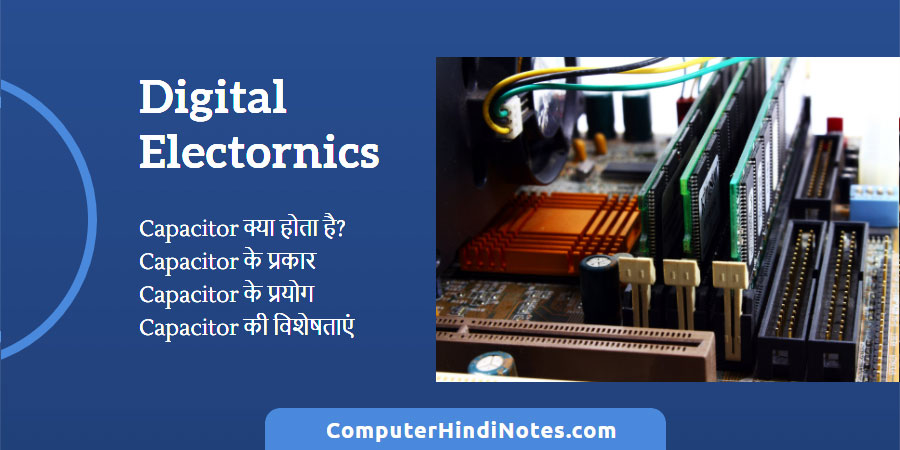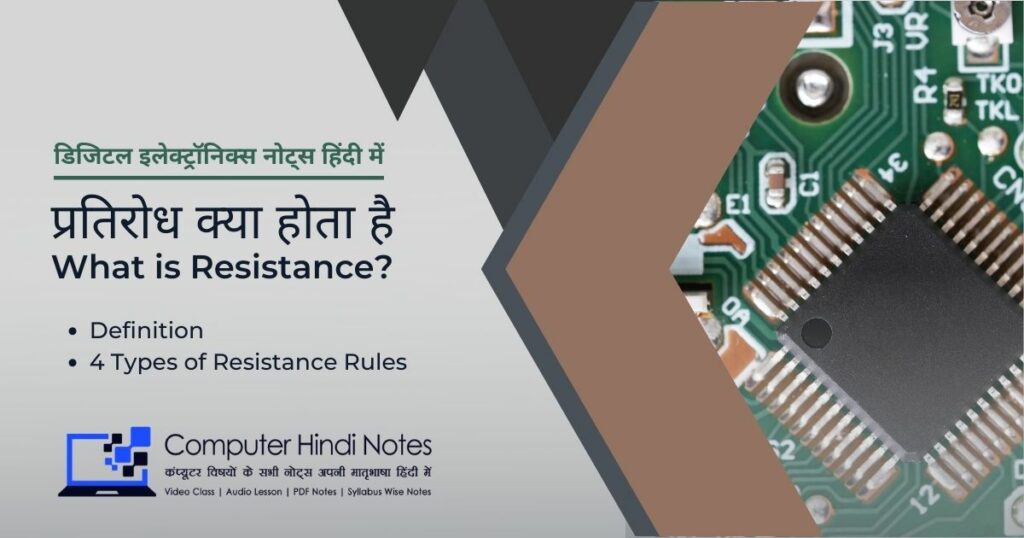Capacitor क्या है? (What is Capacitor)
परिभाषा – Capacitor या Condenser एक insulating medium है जो दो conducting surfaces को अलग कर सकता है। Insulating medium को dielectric constant या material की relative permittivity कहा जाता है। Capacitor में सबसे अधिक उपयोग किए जाने वाले ढांकता हुआ पदार्थ air, mica, paper, ceramic और plastic होता हैं।
Insulating medium DC current को pass करने की अनुमति नहीं देता जबकि, एक AC circuit में, Capacitor के माध्यम से current flows कम और कोई resistance नहीं होता है। Capacitor एक electrical component है जो electrical charge के रूप में ऊर्जा (energy) को संग्रहित कर सकता है।
Capacitor के प्रकार (Types of Capacitor)
- Dielectric Capacitor – यह variable type का है और यह tuning transmitters, receivers, और transistor radios के लिए आवश्यक है। ये dielectric Capacitors multi-plate Capacitors हैं जिसमें fixed plates और movable plates दोनों का एक set होता है। movable plates fixed plates के बीच में move करती हैं।
- Film Capacitor – ये सभी प्रकार के Capacitor के बीच सबसे अधिक उपलब्ध होते हैं। Film Capacitors में Capacitors का एक परिवार होता है, लेकिन उनकी dielectric properties अलग होती हैं। dielectric material में polyester, Teflon, metalized paper शामिल हो सकते हैं।
- Ceramic Capacitor – Ceramic Capacitors को दोनों तरफ से चांदी की coating करके बनाया जाता है और फिर संधारित्र बनाने के लिए एक साथ ढेर किया जाता है। सिरेमिक कैपेसिटर को डिस्क कैपेसिटर के रूप में भी जाना जाता है।
- Electrolytic Capacitor – इस प्रकार के Capacitor का उपयोग तब किया जाता है जब काफी considerable capacitance की आवश्यकता होती है। इनका उपयोग DC power supply circuits में किया जाता है, Electrolytic Capacitors के दो रूप हैं:
- Aluminum Electrolytic Capacitors – ये Capacitors दो प्रकार के होते हैं: Plain foil type और etched foil type। DC current को Capacitors की foil plates के लिए anodize किया जाता है, और इस anodizing process के कारण, poles की polarity को स्थापित किया जा सकता है, और यह contradiction हमें बताता है कि plate का कौन सा पक्ष positive या negative है।
इसके अलावा, उनके पास foil plate को re-anodizing करने की क्षमता है। यदि aluminum oxide की परत नष्ट हो जाती है, तो electrolytic Capacitor condenser से गुजरने की अनुमति देगा और Capacitor को नष्ट कर देगा। - Tantalum Electrolytic Capacitors – इस प्रकार के Capacitor wet और dry electrolytic दोनों प्रकारों में उपलब्ध हैं। dry electrolytic Capacitor सबसे अधिक इस्तेमाल किया जाता है। वे ज्यादातर उन सर्किट में उपयोग किए जाते हैं जहां डीसी वोल्टेज की तुलना में एसी वोल्टेज छोटा होता है।
निम्न कारकों पर एक conductor की capacitance निर्भर करती है:- Plates का आकार : यदि plates का आकार से बड़ा होता है तो वे दिए गए potential से अधिक चार्ज कर सकते हैं|
- Plates के बीच की दूरी : Capacitor का capacitance plates के बीच की दूरी पर निर्भर करता है। यदि दूरी कम होगी तो capacitance अधिक होगा|
- सापेक्ष पारगम्यता (relative permittivity) : Capacitor का capacitance insulating medium की relative permittivity पर निर्भर करता है। relative permittivity अधिक होने पर capacitance अधिक होता है|
- Aluminum Electrolytic Capacitors – ये Capacitors दो प्रकार के होते हैं: Plain foil type और etched foil type। DC current को Capacitors की foil plates के लिए anodize किया जाता है, और इस anodizing process के कारण, poles की polarity को स्थापित किया जा सकता है, और यह contradiction हमें बताता है कि plate का कौन सा पक्ष positive या negative है।
Capacitor की विशेषताएँ (Features of Capacitor)
- सामान्य कैपेसिटेंस (C) : capacitance के standard मान picofarads(pF), nano-Farads(nF) या micro-Farads में मापे जाते है Capacitor का capacitance की circuit की frequency के अनुसार value को बदल सकता है।
- कार्यशील वोल्टेज(Working voltage) : कार्यशील वोल्टेज अधिकतम वोल्टेज है, चाहे वह AC हो या DC हो, जो कि इसकी संपूर्ण working life को तोड़े बिना circuit पर लागू हो सकता है।
- Tolerance (+ -%) : Capacitor की एक tolerance rating होती है, जो Capacitors के लिए Pico-farads में plus या minus value होती है, सबसे common tolerance variation 5% या 10% है।
- रिसाव वर्तमान (Leakage current) : Dielectric medium जिसे हम Capacitor की प्लेटों को अलग करने के लिए इस्तेमाल करते थे, उसमे current का रिसाव(leakage) होता था इसलिए Dielectric medium को सही नहीं कहा जा सकता। current के इस small leakage को Leakage Current के नाम से जाना जाता है।
- कार्य तापमान (Working temperature) : जैसा कि हम जानते हैं, तापमान में परिवर्तन dielectric properties में परिवर्तन की अनुमति देता है, temperature में अंतर capacitance को भी प्रभावित करता है। अधिकांश Capacitor के लिए average working range -30C से +125C होती है।
- तापमान गुणांक (Temperature coefficient) : Capacitor का temperature coefficient हमें किसी विशिष्ट तापमान के लिए capacitance की value में maximum change के बारे में बताता है जो कि million degrees per centigrade के रूप में होता है।
- ध्रुवीकरण (Polarization) : Capacitor polarization हमें electrolytic प्रकार के Capacitors के बारे में बताता है, पर उनमें सही ध्रुवता (right polarity) होनी चाहिए क्युकि जैसा कि हम गलत ध्रुवीकरण (incorrect polarization) को जानते हैं जो कि circuit को नुकसान पहुंचा सकते हैं।
- समतुल्य श्रृंखला प्रतिरोध (Equivalent series resistance) : यह Capacitor की AC impedance है। यह हमें Capacitor के equivalent series resistance के energy loss के बारे में बताता है।
Capacitor के अनुप्रयोग (Applications of Capacitor)
- ऊर्जा के भंडारण के लिए Capacitor का उपयोग किया जाता है।
- Capacitor में ऊर्जा भंडारण(Energy storage) का उपयोग dynamic digital memories के निर्माण के लिए किया जाता है।
- Reservoir Capacitors का उपयोग बिजली की आपूर्ति में किया जाता है|
- Capacitor का उपयोग कई स्पंदित बिजली अनुप्रयोगों(pulsed power applications) जैसे lasers, radar, pulse बनाने वाले network के लिए भी किया जाता है।
- Capacitor का इस्तेमाल power factor correction के लिए भी किया जाता है।
- Capacitor का AC और DC components को अलग करने के लिए उपयोग किया जाता है क्योंकि Capacitor AC को पास करते है और DC को block करते है।
- Capacitor में संग्रहीत ऊर्जा का उपयोग सूचना को represent करने के लिए किया जाता है।
- Radio receivers frequency की tuning के लिए variable Capacitor का उपयोग करते हैं।



